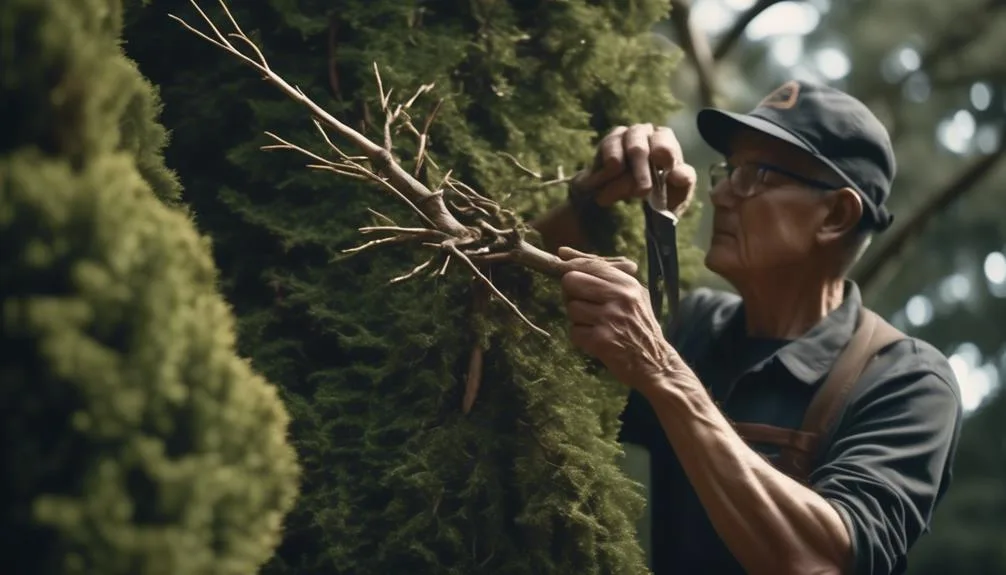Cedar trees, often seen as symbols of strength, also need maintenance like any well-built structure. Pruning plays a vital role in keeping these sturdy trees healthy and attractive.
But why is pruning necessary for cedar trees, and when is the best time to do it? Understanding the importance of pruning and the optimal timing can significantly impact the overall health and appearance of your cedar trees.
Benefits of Pruning Cedar Trees
Pruning cedar trees not only enhances their overall appearance but also promotes healthier growth and reduces the risk of disease and pest infestation.
When you prune your cedar trees, you encourage improved growth by removing dead, damaged, or diseased branches, allowing the tree to focus its energy on developing new, healthy growth. This results in a fuller, lusher appearance and enhanced aesthetics for your landscape.
Additionally, pruning helps to maintain the tree's natural shape and structure, preventing it from becoming misshapen or overcrowded. By keeping the tree's growth in check, you also reduce the risk of disease and pest infestation, as proper pruning allows for better air circulation and sunlight penetration throughout the tree.
This proactive approach to tree care ensures that your cedar trees remain healthy and vibrant for years to come.
Signs That Cedar Trees Need Pruning
Before pruning your cedar trees, it's important to be able to recognize the signs that indicate they need pruning. Look for dead, diseased, or damaged branches as these can hinder the tree's growth and overall health. Dead branches aren't only unattractive but can also be a safety hazard.
Additionally, if you notice branches that are crossing or rubbing against each other, it's a sign that pruning is necessary to prevent damage and promote healthy growth. Keep an eye out for dense foliage that blocks sunlight from reaching the inner parts of the tree, leading to poor air circulation and potential disease.
Best Time to Prune Cedar Trees
To ensure healthy growth and minimize stress on the tree, it's essential to prune cedar trees during the dormant season, typically in late winter or early spring. Pruning during this time allows the cedar tree to recover quickly and flourish once the growing season begins.
Here are some key reasons why late winter or early spring is the best time to prune cedar trees:
- Tree Health: Pruning during the dormant season reduces the risk of disease transmission and allows the tree to heal more effectively.
- Growth Patterns: Pruning at this time encourages new growth in the spring, promoting a healthy and vibrant cedar tree.
- Minimize Stress: Pruning during dormancy minimizes stress on the tree, as it isn't actively growing or producing new foliage.
- Optimal Healing: Wounds from pruning are more likely to heal quickly during the dormant season.
- Improved Aesthetics: Pruning in late winter or early spring helps maintain the desired shape and appearance of the cedar tree.
How to Properly Prune Cedar Trees
When considering the proper method for pruning your cedar trees, it's important to begin by assessing the tree's overall health and growth habits. Proper pruning techniques are essential for maintaining the health and appearance of your cedar trees.
Start by removing dead or diseased branches to prevent the spread of illness and promote new growth. Focus on maintaining the tree's natural shape and avoid cutting into the green foliage unless necessary. Be mindful of the size and location of the branches you prune, as this can impact the tree's overall health.
It's important to use sharp, clean tools to make precise cuts and minimize damage to the tree. By following these guidelines and keeping the tree's health in mind, you can ensure that your cedar trees remain strong and vibrant for years to come.
Common Mistakes to Avoid When Pruning Cedar Trees
Avoid making the mistake of indiscriminately cutting into the green foliage of your cedar trees when pruning, as this can negatively impact their health and appearance. To ensure that you're not inadvertently harming your cedar trees while pruning, here are some common mistakes to avoid:
- Over-Pruning: Trimming too much foliage at once can stress the tree.
- Using Incorrect Tools: Using dull or improper tools can cause damage to the tree.
- Ignoring Pruning Techniques: Improper cuts can lead to disease or slow healing.
- Pruning at the Wrong Time: Pruning at the wrong time of year can weaken the tree.
- Failing to Sanitize Tools: Not cleaning tools can spread diseases between trees.
Conclusion
To maintain healthy and vibrant cedar trees, regular pruning is essential. Keep an eye out for signs of overgrowth or dead branches, and schedule pruning for late winter or early spring.
Remember, using proper pruning techniques is crucial for the overall shape and well-being of your cedars. By avoiding common mistakes, such as cutting too close to the trunk, you can ensure their longevity.
With the right care, your cedar trees will continue to flourish for years to come, adding beauty and vitality to your surroundings.

My interest in trees started when I first saw the giant sequoias in Yosemite.
I was a teenager then, and I remember thinking, “I need to learn more about this.”
That moment stuck with me.
A few years later, I went on to study forestry at Michigan Tech.
Since graduating, I’ve worked in a mix of hands-on tree care and community education.
I’ve spent over ten years helping people understand how to plant, maintain, and protect the trees in their neighborhoods.
I don’t see trees as just part of the landscape.
They are living things that make a real difference in our daily lives.
